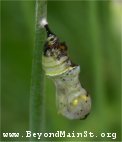
Monarchs have been going mad over the Swamp Milkweed this year. We counted seven or eight fat, yellow-black-and-white banded monarch caterpillars on one stand near the driveway this year, so it was only a matter of time before the we spotted the first one clutching to a chive stalk one evening back in late August, stretching its body out like a branch, ready to weave his chrysalis.
 We expected it to happen overnight, and charged our camera batteries up to get some shots of the cocoon and emerging butterfly come morning. What we saw was beautiful, fascinating and kind of gross all at the same time. To say the cocoon looked like spun glass would be a lie; it looked more like spun jade; a light green flecked with spots of yellow. The backside of the chrysalis, however, was completely caved in, and the mass that remained -- what was probably the caterpillar itself-- was a mottled brown jelly, with the black, jagged lips of the chrysalis puckered and twisted around it.
We expected it to happen overnight, and charged our camera batteries up to get some shots of the cocoon and emerging butterfly come morning. What we saw was beautiful, fascinating and kind of gross all at the same time. To say the cocoon looked like spun glass would be a lie; it looked more like spun jade; a light green flecked with spots of yellow. The backside of the chrysalis, however, was completely caved in, and the mass that remained -- what was probably the caterpillar itself-- was a mottled brown jelly, with the black, jagged lips of the chrysalis puckered and twisted around it. What could have caused this? According to Oakley Beisanz, naturalist and volunteer coordinator at the Maplewood Nature Center, it could have been several things, including an attack by ants, or eggs laid by predatory wasps (females often use their ovipositor to bore holes into cocoons and deposit eggs, when they hatch the wasp larva will eat the caterpillars alive).
What could have caused this? According to Oakley Beisanz, naturalist and volunteer coordinator at the Maplewood Nature Center, it could have been several things, including an attack by ants, or eggs laid by predatory wasps (females often use their ovipositor to bore holes into cocoons and deposit eggs, when they hatch the wasp larva will eat the caterpillars alive).While wasps are a native and beneficial species, there are certain steps, according to some websites, that can be taken to protect native butterflies, including placing caterpillars in a screened container out of direct sunlight on a porch or inside your home. Provide them with adequate water and host plant material (for Monarchs, it's almost any native milkweed; for others, see here,) release the butterflies when they emerge. I'm not sure how this ranks with all the wildlife rehabilitationists out there who urge people not to take wild animals into their home, but it might be an interesting project some year. With the onset of an early fall, I doubt we'll see many more Monarchs in 2006.

No comments:
Post a Comment